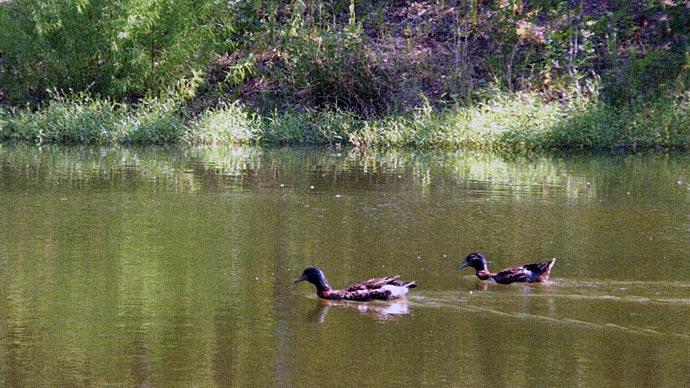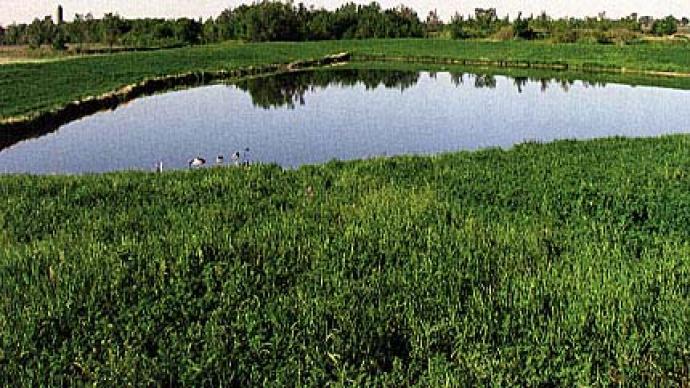With thirty-something summers under my career belt, you can only imagine the sites I've seen and stories I've heard. With a vantage point high inside the air-conditioned cab of a roaring piece of heavy equipment, many of these sights and stories can quickly be changed. Whether building a brand new lake and dam, or dealing with erosion issues from an older site, hot summer months can be the best time to fix maintenance issues that seem to plague too many landowners.
During late winter and spring months, much of the country is blessed with maximum nourishing rains, geographically and proportionately the biggest amounts of the year. When rain comes, moving water picks up and transports everything it can from dirt and organic matter to dissolved minerals. And, water always seeks the path of least resistance, over and over.
Erosion occurs, ruts happen. New smooth, unvegetated dams take on a new look., like your very own version of a series of mini-grand canyons. Sloped dirt moves fast, then as water slows, stuff drops, usually in the bottom of your pond or creek.
We just finished a classic case history in summertime work. This latest project involved a small pond, drawn down four feet due to dry weather conditions. Around here, water can evaporate at the rate of an inch every three days, depending on heat and humidity. So, without runoff rains, pond levels drop. Much of the upper end of this pond is typically two feet deep or less, when full. I have a rule of thumb, learned over years of building lakes and ponds and moving dirt. Water less than two feet deep is most economically handled by filling, water two feet deep or more, excavate. We took excavated dirt, pushed toward shallower areas and filled. We sculpted the shoreline, deepened some areas, built up other areas, and reconfigured the pond. Here's a tip. If you intend to deepen an area of your pond this time of year, use what I call the "half and half system. Take half the dirt to create depth, and use that half to fill a shallow area. You get the best of two worlds, without an ugly mountain of dirt unnaturally changing the landscape of your property.
There's other issues.
I'll never forget the call from one prospective client. He said, "The only way I can get to my property any more is by parachute!" Compelling argument. He had lots of issues. His dam was eroding. Roads were washed and rutted so deep he couldn't drive a four wheeler through it. Hiking trails around the pond were washed out. His weekend paradise was beginning to look like a bombed out military target, all because he didn't understand the significance of erosion control of disturbed soils.
If your dam shows signs of repetitive straight down erosion, and you can't seem to establish grass on the steep slope, here's a few hints. Use the small water puddle forming inside the pond to irrigate your dam to grow grass. Rent or buy a gasoline powered pump and use a portable irrigation system. Maintaining the dam in the beginning is much more important than impounding water to stock fish. What grass to plant? Depends on the season, and your geographic location. Contact local consultants, county agents, or NRCS offices for the best advice. If "sheet" erosion continues to be a problem, build a small horizontal terrace to redirect water off its vertical desires. You can effectively move rainfall runoff toward slower slopes, minimizing effects of erosion. Another common method uses square bales of hay in a line to slow water movement and redirect it elsewhere, other than straight down your dam. Hydromulching can be effective, especially when you have water available to tender shoots of young sprouting grass. There are now biodegradable mats which look similar to bird netting. Scatter seeds, put down the mat, add water. The mat holds soils in place, allows seeds to sprout through, then melt with dirt over time. If none of these techniques are attractive to you, buy turf grass sod and plant. You won't be the first to do it.
If you constantly have hot summer winds thrashing waves across your dam, the best choice may be riprap. One client of ours raised a dam on an old pond, then was puzzled by how quickly erosion ate away the soils. By the time he noticed it, the old contractor was gone, and we were on site. The decision was made to buy several tons of riprap, rocks big as basketballs, to stack along the inside of the dam, to stop heavy erosion. If your dam is eroding, and you catch it early enough, repairs can be made by hand, or with a small utility tractor. Here's what you can do. Fill the eroded areas with good soils, pack, then plant. Get plants growing. If the problem is recurring, build diversion terraces described above. Reshape the rough spots to your liking, then go on the defensive to slow erosion while the bank heals with plant life.
Work on roads and crossings upstream from your lake. Summer is a good time to install a culvert, build upstream silt trap ponds and other water management devices to minimize siltation of your main lake.
Building and maintaining a road upstream helps keep vehicles off the dam. Roads off a dam are easier to maintain and repair than those on top of a dam. Look at your emergency overflow spillway, make sure it's not eroded. If it is, repair now. Reestablish grass. If need be, change the spillway to the other side, to let the first side "heal".
During summer, overflow pipes may be exposed, now is the time to maintain, weld, repair pipe on front slope side. Also, summer months are a good time to correct backside overflow pipes, stop erosion, and maintenance. Most corrections are things that, if built right in the first place, you wouldn't be dealing with right now.
All dams have erosion problems at some point, especially from wind and wave action. Good grass is our best friend, but when the lake drops the lower levels may not have grass. Then, stop erosion the best way possible. Some people use small rocks, or sacks of ready mix concrete. Small repair works for small projects. Inspect often.
Once grass is established, remove hay bales and maintain. Being able to maintain will increase the life of your lake and make it more enjoyable.
Another client, several years ago, wanted to deepen his lake. Water levels were down to record lows due to an ongoing drought. It was easy to get the dozers inside the pond. He decided he wanted us to build an island. So, we mixed good clay subsoils with years of silt buildup and built a nice island. It was attractive, sitting two to three feet above the filled lake waterline. The problem? The island soon was covered with unattractive plants and weeds, then willow trees around all edges with cattails. After three years, you couldn't see the island. More maintenance.
While maintaining roads, think about drainage areas that feed your pond. Be sure your roads have crowns, and each side of the road has a well thought out drainage pattern. Guide the water in an orderly way, through a greenbelt, under culverts, into a creek, or straight into your pond. That's a decision worthy of thought.
Got a fence through your pond, to keep cattle off the dam, or neighbors off the fish? Maintain it now, while water levels are low. Maintaining a fence from a boat isn't easy.
Burying pipe, electric conduit or septic systems? Summer is the best time, while soils are driest.
Cattails ringing pond's edge? Want to dig them out? Summer is the time. Just remember, the spoils of digging cattails and reeds will be loaded with viable roots. Don't dig from one spot, then inadvertently plant in another area.
We just finished a year long project. Soils were too dry to move, then too wet. Steep slopes were tough to navigate, and the landowner wanted this lake to be built exactly to his specs. We were at the mercy of weather and humanity. As a final thrust to finish, we were admiring a sharp looking vertical bank directly across from the cabin. "Fish will love it," he smiled. "No doubt," was my remark. The bank shot up fifteen feet from the lake floor, next to a site his wife had already picked out to build a park-like picnic area. She heard our comments, and directly ignored them. She said, "I don't like it at all." With sideward glances toward each other, we sang out together, "Why not?".
Her point was well taken. "It's not safe. If someone slips into the lake here, they will be way over their heads, and could panic."
I climbed back onto the dozer, and we created a shelf, four feet underwater, then another eight feet under the surface. Like stair steps. Momma was happy, and bass have a multi-level condominium.
Upstream of this lake were several other steep areas. Momma wanted a trail all the way around the lake. So, as we left, the family was building two footbridges across a tall, narrow span. Summer time work.
Want to build a boat launch ramp? Summer is a good time for that, too.
Excavating a nuisance beaver lodge? You can see more of it when water levels drop.
Wet spots behind the dam? Summer is the time to repair or redirect those seepholes. Backslope of the dam needs some care? Summer time is a good time.
After so many dams, so many summers working with heavy equipment, dirt and people, I have seen many different scenes and many ideas come and go. But, one thing has been absolutely constant. Ponds, roads, land...need maintenance. Don't ignore it. Watch, be aware of what happens to your land. Some simple problems, when ignored, can become significant problems. Catch them early, solve, then maintain.
Or, wait a while, then call me.
The author is a 35-year veteran of pond construction, from dairy lagoons in Ohio to golf course water hazards in Florida to recreational fishing ponds in Oklahoma. He may be reached at Otto's Pond Service 1-800-882-DIRT
Reprinted with permission from Pond Boss Magazine



